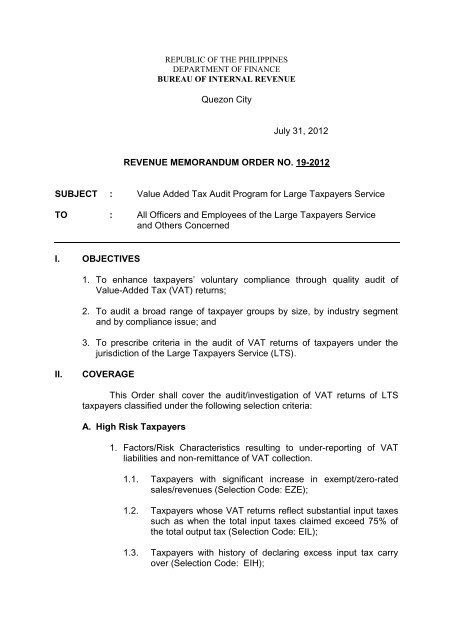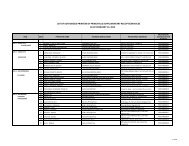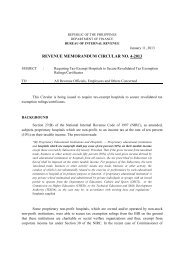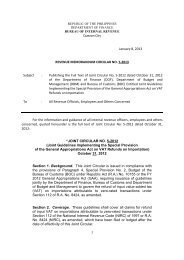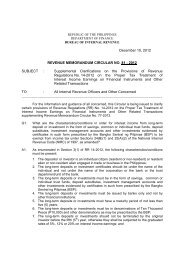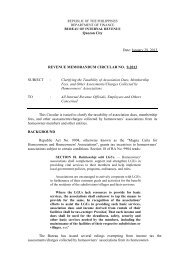revenue memorandum order no. 19-2012
revenue memorandum order no. 19-2012
revenue memorandum order no. 19-2012
You also want an ePaper? Increase the reach of your titles
YUMPU automatically turns print PDFs into web optimized ePapers that Google loves.
REPUBLIC OF THE PHILIPPINES<br />
DEPARTMENT OF FINANCE<br />
BUREAU OF INTERNAL REVENUE<br />
Quezon City<br />
July 31, <strong>2012</strong><br />
REVENUE MEMORANDUM ORDER NO. <strong>19</strong>-<strong>2012</strong><br />
SUBJECT : Value Added Tax Audit Program for Large Taxpayers Service<br />
TO : All Officers and Employees of the Large Taxpayers Service<br />
and Others Concerned<br />
I. OBJECTIVES<br />
1. To enhance taxpayers’ voluntary compliance through quality audit of<br />
Value-Added Tax (VAT) returns;<br />
2. To audit a broad range of taxpayer groups by size, by industry segment<br />
and by compliance issue; and<br />
3. To prescribe criteria in the audit of VAT returns of taxpayers under the<br />
jurisdiction of the Large Taxpayers Service (LTS).<br />
II. COVERAGE<br />
This Order shall cover the audit/investigation of VAT returns of LTS<br />
taxpayers classified under the following selection criteria:<br />
A. High Risk Taxpayers<br />
1. Factors/Risk Characteristics resulting to under-reporting of VAT<br />
liabilities and <strong>no</strong>n-remittance of VAT collection.<br />
1.1. Taxpayers with significant increase in exempt/zero-rated<br />
sales/<strong>revenue</strong>s (Selection Code: EZE);<br />
1.2. Taxpayers whose VAT returns reflect substantial input taxes<br />
such as when the total input taxes claimed exceed 75% of<br />
the total output tax (Selection Code: EIL);<br />
1.3. Taxpayers with history of declaring excess input tax carry<br />
over (Selection Code: EIH);
1.4. Taxpayers filing VAT exempt tax returns due to availment of<br />
tax incentives or tax exemptions (Selection Code: ETI );<br />
1.5. Taxpayers with history of filing claim for refund and/or<br />
request for issuance of Tax Credit Certificate (TCC)<br />
(Selection Code: CTC);<br />
1.6. Taxpayers with substantial sales but reporting net loss<br />
(Selection code: SNL ) ;<br />
1.7. Taxpayers with drastic decrease in reported sales/VAT<br />
payments or with marked deviation from industry trends<br />
(Selection Code: DIT); and<br />
1.8. Taxpayers identified as High Risk based on the result of the<br />
LTS Compliance Risk Matrix analysis (Selection Code:<br />
CRM).<br />
2. Compliance Risk Characteristics due to <strong>no</strong>n-compliance to<br />
administrative requirements.<br />
2.1. Taxpayers with acquisition of more than one (1) million in<br />
capital assets and failed to amortize the input tax as required<br />
(Selection Code: ACA);<br />
2.2. Taxpayers who are <strong>no</strong>n-compliant in the submission of SLP<br />
and SLS, MAP, SAWT and other mandatory requirements<br />
(Selection Code: NCT);<br />
2.3. Taxpayers who are <strong>no</strong>n-compliant with RMO No. 12-<strong>2012</strong> –<br />
the Electronic Sales Reporting (Selection Code: ESR); and<br />
2.4. Taxpayers transacting with the government or any of its<br />
political subdivisions, instrumentalities or agencies,<br />
including government owned or controlled corporation<br />
(GOCC) (Selection Code: GPA).<br />
B. Medium Risk Taxpayers<br />
1. Business Issue Risks/Complex Industries due to industry issues and<br />
changes in the status/registration of business.<br />
1.1. Taxpayers with complex corporate structures, including<br />
mergers/consolidations/split-up or down/ spin-offs and other<br />
types of corporate reorganizations (Selection code: CCS);<br />
1.2. Taxpayers with application for cessation/retirement of<br />
business (Selection Code: CES);
1.3. Taxpayers with multiple branches/outlets all over the<br />
Philippines but reported low sales (Selection Code: RLS);<br />
1.4. Taxpayers with sale or transfer of business. (Selection Code:<br />
STB); and<br />
1.5. Taxpayers with multiple lines of business with different basis<br />
for computation of VAT liabilities (e.g. sale of services - VAT<br />
is computed on gross receipts, sale of goods where VAT is<br />
based on gross sales, etc.) (Selection Code: MLB).<br />
2. AUDIT POLICIES AND PROCEDURES<br />
1. The VAT Audit Program shall be implemented on September <strong>2012</strong><br />
in LTS. A VAT Audit Team shall be created and will be composed of<br />
two (2) VAT Audit Team Heads and five (5) audit groups.<br />
2. The VAT Audit Team shall be given the responsibility of<br />
investigating VAT returns of LTS taxpayers. They will prepare list of<br />
taxpayers (using the format prescribed in Annex “A”) recommended<br />
for audit based on the selection criteria specified in this Order and<br />
submit the same to the Assistant Commissioner, Large Taxpayers<br />
Service (ACIR, LTS) for approval.<br />
3. One (1) e-Letter of Authority (eLA) shall be issued for each taxable<br />
quarter/semester duly approved by the ACIR, LTS upon the<br />
recommendation of the VAT Audit Team Heads. However, if there is<br />
a deficiency for the current period under audit, and a possibility that<br />
the tax issue that gave rise to deficiency would also be present in<br />
prior period/s, an eLA can also be issued for the said period/s.<br />
4. The basic audit procedures prescribed in Revenue Audit<br />
Memorandum Order (RAMO) No. 1-99 and other issuances<br />
particularly those with impact on VAT audit shall be strictly observed.<br />
Moreover, ROs must thoroughly understand the business operation<br />
of the taxpayer and a detailed discussion must be included in the<br />
<strong>memorandum</strong> report.<br />
5. If a taxpayer has already been issued an eLA for all internal <strong>revenue</strong><br />
tax liabilities for a particular period and a significant finding/s on VAT<br />
was uncovered, it should be communicated to the VAT Audit Team<br />
for possible risk identification in the current period under audit.<br />
6. If an eLA has already been issued under the VAT Audit Program and<br />
the taxpayer becomes a candidate for regular audit in the concerned<br />
division based on the selection criteria under the annual audit<br />
program, the request for eLA should <strong>no</strong>t include the VAT liability of<br />
the taxpayer.
7. The VAT Audit Team Head should transmit a copy of the VAT audit<br />
findings to the concerned Division conducting the regular audit to<br />
determine their relevance and effect to other tax liabilities.<br />
8. Assignment of cases shall be done by the VAT Audit Team Head for<br />
their respective groups/members in accordance with existing<br />
regulations, taking into consideration the accomplishment and<br />
workloads of the Revenue Officers (ROs).<br />
9. The initial workload of each RO under this program shall be twenty<br />
(20) cases. In <strong>no</strong> case shall the total number of cases handled by an<br />
RO exceed twenty (20) cases which shall be subject to replenishment<br />
after every submission of report/s of investigation of closed case/s.<br />
Cases returned to the RO after review for compliance of some<br />
findings shall be given top priority action and must be submitted<br />
within fifteen (15) days from receipt of the docket.<br />
Cases returned for continuance of investigation due to resolution of<br />
certain legal issues or after compliance to the Subpoena Duces<br />
Tecum (SDT) by the taxpayer, shall form part of the inventory of the<br />
RO.<br />
However, excess in the allowable limit of twenty (20) cases as a<br />
result of returned case/s shall <strong>no</strong>t be considered as a violation of this<br />
Order.<br />
10. The mandatory reporting requirements prescribed in Annex “B“ of<br />
Revenue Memorandum Order (RMO) No. 53-98, as amended by<br />
RMO Nos. 16-2007, 22-2007 and Revenue Memorandum Circular<br />
(RMC) No. 29-2009, in relation to big ticket items, shall be strictly<br />
observed by all ROs concerned.<br />
11. The issuance of Preliminary Assessment Notice (PAN) and<br />
Final Assessment Notice (FAN) for deficiency VAT liabilities as a<br />
result of the audit will be in accordance with existing<br />
regulations/issuances.<br />
12. If the taxpayer fails to settle/pay the VAT assessment or fails to<br />
file a protest within the prescribed period from receipt of the PAN, the<br />
VAT Audit Taskforce shall recommend the issuance and prepare the<br />
Final Assessment Notice (FAN) to be approved and signed by the<br />
ACIR, LTS.<br />
13. All audit reports shall be approved by the ACIR, LTS thru the<br />
concerned VAT Audit Team Head.<br />
14. Any violation of this Order shall be a ground for the imposition of<br />
appropriate administrative sanctions/penalties.
3. REPORTING REQUIREMENTS<br />
1. The Group Supervisors shall submit Monthly Report of All Cases Acted<br />
Upon (Annex ”B”) and Monthly Report of Pending Cases (Annex “C”) of<br />
their respective groups to the concerned VAT Audit Team Head who<br />
will submit Consolidated Monthly Reports (Annexes B1 and C1) to the<br />
ACIR, LTS on or before the 8th day of the following month.<br />
2. The ACIR, LTS shall submit to the Management Committee a quarterly<br />
report on the results of audit with appropriate recommended action/s<br />
based on the reports submitted by the VAT Audit Team Heads.<br />
4. DEVIATION FROM POLICY<br />
Any deviation from the above policies shall be allowed only upon prior<br />
written authorization from the Commissioner, as recommended by the ACIR,<br />
LTS.<br />
5. REPEALING CLAUSE<br />
All other issuances inconsistent herewith are hereby modified or<br />
repealed accordingly.<br />
6. EFFECTIVITY<br />
D11<br />
This Order takes effect immediately.<br />
(Original Signed)<br />
KIM S. JACINTO-HENARES<br />
Commissioner of Internal Revenue


